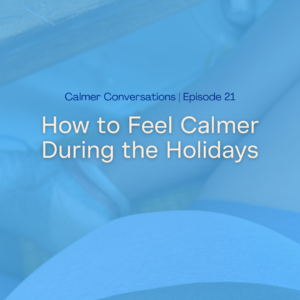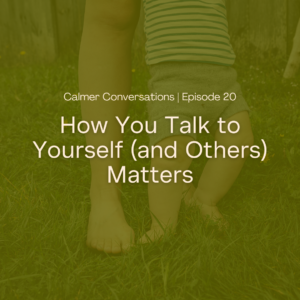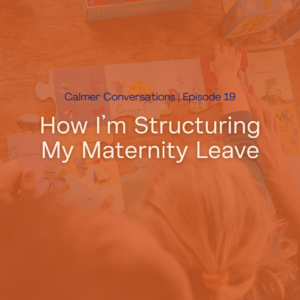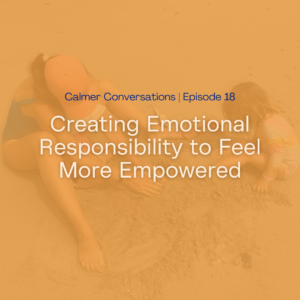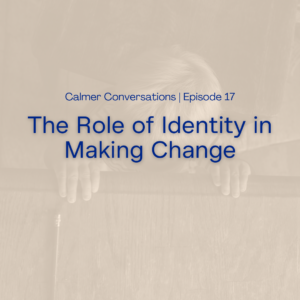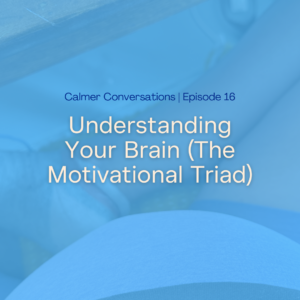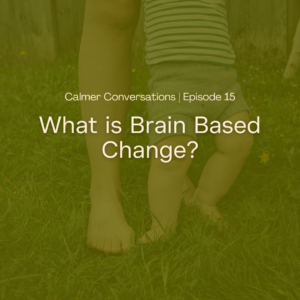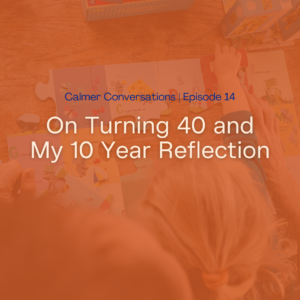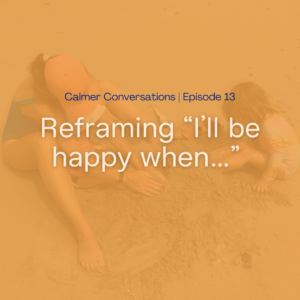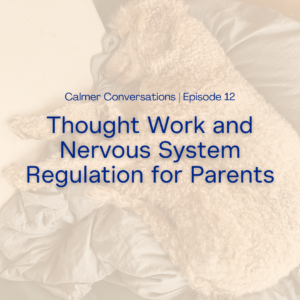Cecelia Baum Mandryk (00:02.574)
Hey and welcome to Calmer Conversations. Cecelia, your host. And just to remind you, this is where we talk about mindset and mindfulness as tools and methodologies for changing how you feel in life. So you can help your brain be a calmer place to be. So you can help your life be a more content, joyful, amazing life to live. So you can work with yourself instead of against yourself because so many of us inadvertently are working against ourselves.
Okay, so last week, if you tuned in, I talked about noticing. And I said that we were gonna have a part two and it was gonna be noticing in a different way. So using noticing to help yourself change instead of getting stuck. What if how you noticing, notice something, how you notice yourself, how you notice your behaviors is the difference between staying stuck in the same loops and shifting out of the loops. So many women that I work with are great at noticing what’s wrong. They’re great at noticing patterns, but they need a different skill.
to shift into seeing what’s possible. And so we’re gonna use noticing as a skill to shift into what’s possible as shift into a way of working with your brain instead of a way to stay stuck. So last week I talked more about how we use it to stay stuck. And I talked about it primarily from a place of even just the, where some people get where there are, and I use therapy as the example, you’re in a situation and you notice that something has been kind of really powerful for you and helped you change.
And then all of sudden you feel like you’re stuck in the same patterns, but you don’t even necessarily need to be in therapy to notice this, but you’ve noticed the patterns in your life. And oftentimes, if we are not adept at working with our brains, if we haven’t learned some of these skills, the noticing kind of feels like a way to shame ourselves, to fall into guilt, to should ourselves, to should other people around us.
Cecelia Baum Mandryk (02:20.461)
Because we think that noticing in this way, we kind of have the thought error that if we notice things in this way that they will actually cause change, right? If I bring attention to what I don’t like, then it will help me change. But ultimately, what ends up happening is we notice these patterns we’re in, but we don’t actually use it for any kind of change. So we notice in a way that’s full of judgment, we notice in a way that’s full of urgency, we notice in a way that’s full of shame, we notice in a way that’s saying that my happiness or my contentment
from this outside thing changing. So we notice the outside, we notice our projections, and in many ways that keeps us stuck in the same cycle. So the opposite of this and a different way to take it is to start to use gentle observation. And I use the term gentle observation here. You could also use non-judgmental observation if you’ve heard that. Awareness, awareness without attachment.
you’re holding something really lightly in your brain. And in some ways you’re becoming the person who is aware of the observation instead of the person who is in the observation. When we’re in noticing that feels stuck, we are the thing. We are more connected with it, we’re judging it, we are really closely tied with it. When you start to move into noticing as a tool for change, you start to become aware of how you’re noticing it. So this gentle observation is you’re noticing it with
out judgment, right? You’re noticing from a non-judgmental perspective. And what that might look like is stepping into something like curiosity over criticism. And I actually want to just back up a little bit before I get into the curiosity over criticism, because what I want you to start noticing and how you can start using noticing as more of a tool for change is instead of noticing everything outside of you, we’re using this gentle observation to turn more internally, to notice our
own internal environment, our own specifically thoughts and emotions, also physical sensations because they can be really powerful. You can start to notice nervous system activation, you can start to notice the thought patterns you’re in, you can start to notice physical sensations, emotions that are coming up. Really truly though focusing on the thoughts and the emotions are the most powerful places to put this awareness, this noticing. And how this looks different from the noticing that keeps you stuck
Cecelia Baum Mandryk (04:44.673)
It’s very often when we’re noticing things that keep us stuck, we’re noticing things outside of ourselves. We’re noticing that we’re with the same romantic partner over and over again. We’re noticing that we keep getting frustrated in the same way, that the same money stuff keeps coming up. We start to notice the patterns outside of ourselves and we think that we need to change those patterns in order to feel better. When you start to notice your internal patterns and you start to take responsibility for how you feel,
that’s where the real change can start to take place because it’s in recoding the internal observations and well not recoding the internal observations noticing what’s going on inside of you and then creating new lines of code, new neural pathways. That’s where real change takes place. But we want to notice these internal patterns and even the external ones at first without judgment, right? So curiosity over criticism, right? how interesting that I’m procrastinating working out again. how interesting.
that I’m getting frustrated with my partner at family dinner time again. How we’re, instead of condemning ourselves, I shouldn’t be feeling this way or this person shouldn’t be feeling, shouldn’t be doing this or I shouldn’t be doing this. I’m a bad person because I’m progressing in my workout versus isn’t it interesting? Great, what is this showing me?
What is the story that’s leading to this instead of there’s something wrong with me in this situation or there’s something wrong with somebody else in this situation?
To add onto this, can start to name without judgment, right? So naming, I’m feeling something versus I am some way. This person is doing something versus this person is some way. And when you start to add a little bit of distance, so softness, a non-judgmental, but also a little bit of distance, a little bit of reporting quality almost, a little bit of bringing it into the moment, you stop identifying with it so much.
Cecelia Baum Mandryk (06:43.977)
when we notice, when you start to work with your brain and you start to notice thoughts, you’re really noticing identities, belief systems, belief patterns, and those are the ones that we’re starting to kind of untie a little bit. And this is, so the zooming out is that part of it, right? So zooming it out, so you’re not so in it. What is underneath the pattern? What is the thought underneath the pattern? And as related to this, we’re kind of taking the
the knowledge that your brain is not telling you truths. Your brain is repeating your most practiced thought in each scenario. And so when your brain is practicing its most practiced thought, it will continue to practice the same thought over and over again. But when you ask your brain to step back and say, okay, this isn’t a truth, this is just a thought, this is just a line of code. And if I notice this with curiosity and kindness,
without judgment, with a little bit of distance, then suddenly I can see it for what it is. I’m in a pattern of telling myself that I need, that growth comes from discontentment, comes from noticing what’s wrong, comes from a struggle or having to solve a problem. And when I stay in that space, of course I’m always gonna find something wrong with what my partner’s doing. I have a thought pattern that I never follow through on.
on my goals with myself. I have this belief system and when I have this belief system, of course I’m self-sabotaging and procrastinating my workout. Right? So instead of just noticing the procrastination, we’re noticing the thought pattern behind it. And when you notice the thought pattern behind it and you accept it and you even maybe offer some forgiveness, some gratitude for that part of you that needed to believe that, that helped that that was adaptive at some point in time to have that thought system, then you can start to shift with it.
So if you want to start bringing this into your own life, first, this is really powerful to do with other people. I I just mentioned that your brain is not always telling the truth. It’s just telling a practice thought. Unfortunately for each of us, it’s sometimes really hard to notice your thoughts as thoughts. They feel so true to us because we’re so used to saying them to ourselves that it can be really hard to see them, to hear them. We need somebody else to point them out to us. And that’s where
Cecelia Baum Mandryk (09:02.029)
coaching comes in, right? Because somebody else gets to see your brain and comment on your brain. That’s not to say that you can’t do this work by yourself, but that it’s oftentimes quicker and it’s oftentimes more rewarding and you can kind of make quantum leaps if you are willing to let somebody else look at your brain. That being said, you can start to pick some place in your life, some place where you’re trying to make a change and see what you can notice. What identities do you have there? What belief systems do you have there?
How have these belief systems and identities supported you? So the first part might just be noticing what you think around working out. What’s coming up when you’re procrastinating? And there’s going to be a lot of surface stuff, but then there are oftentimes some deeper ones, and those are the ones that you want to latch onto. Those big ones, right? So this belief, I never follow through on my commitments to myself. And noticing, okay, that’s a belief system that I have. If I have that belief system,
If I don’t change that, I cannot force my way out of procrastination. I can for a little bit of time, I can maybe today, maybe for the next week, but ultimately I will revert to self-sabotage because I have this belief that I don’t follow through on these things or I’m not worthy of following through on them. And so noticing those and working from that place is where you want to start. Then, when you start to notice the thoughts, treat it as information, right? So,
What is this telling me about me? Where did I get this? Where did it come from? Can I disprove it in some way? Can I start to work with it to kind of untangle it? And then lastly, if there’s one micro shift that I can make to this belief, what would it be? So for instance, I wonder what it would be like to follow through on something for myself. So that could be the third step if you wanna start to work with this. Alternatively,
You could stay in gratitude and thanks for the version of you that has had this past one and oftentimes that will help you let it go. So to kind of wrap up, noticing is not just about catching what’s wrong, right? Noticing can be the first step towards creating the life that you want, towards feeling differently in your brain. But in first, you have to start to notice what’s going on within you, not just outside of you and notice what’s going on within you without judgment.
Cecelia Baum Mandryk (11:21.515)
with a little bit of softness, with a little bit of curiosity, with a little bit of distance and zooming out. And from that space, you can start to take whatever you notice about your brain as information that you can use to move forward in your life, that you can use to rewrite your neural pathways and your truths and your coding so that you can start to show up differently. Okay.
I want you to try this out for a few days. If this sounds interesting to you, see if you can pick an area of your life where change is happening, where you want to start to notice them. Do it. Get back to me and let me know how it goes. And again, if you want to do this in a supported place, because there’s so much change happening within the Life Lab, within the folks who are in there who are doing this, whether they’re coming live or they’re watching replays, even if they’re engaging once a month, they’re doing this work. And I’m going to use air quotes here very imperfectly. You will see major changes in your life.
Get in, come join me, try it out, see what it’s like, see what it’s like to use this approach to change your brain. And if you just want to kind of get a little bit of a deeper taste of this, try the five minute shift. This is where I walk you through processing an emotion and really starting to implement this work in your life in a real way. Or just use this episode, right? Use the steps that I outlined here. Try and use noticing in a different way because it is something, it’s a foundational step that I use over and over again, that my clients use over and over again.
and often is the beginning, is the seed for major change in our life. All right, thank you so much for being here today. Get in touch, let me know what you think. If you liked this episode or if you’d like some other topic, if you’d like for me to talk about something, make sure you let me know. Write a review if you liked it, share it with somebody you love, and I will see you the next time.




